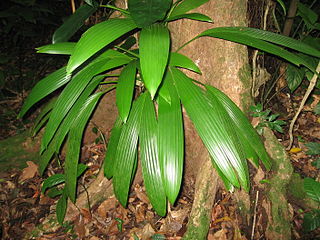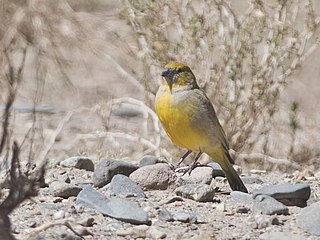
Asplundia is a genus of plants belonging to the family Cyclanthaceae. They are distributed in the Neotropical realm from southern Mexico to southern Brazil.
Napoleonaea lutea is a species of woody plant in the family Lecythidaceae. It is found only in Nigeria. It is threatened by habitat loss.
Geocrinia leai, sometimes called Lea's frog, is a species in the taxonomic family, Myobatrachidae and is endemic to southwest Australia. As with the other species in the genera, Geocrinia, it is restricted to the high rainfall region at the south west of Western Australia; the very same Walpole/Nornalup district occupied by cogenor Geocrinia lutea. Ecology is similar to that of Geocrinia rosea, part of the so-called 'roseate complex'.
Geocrinia lutea is a species of frog in the family Myobatrachidae. It is sometimes named for the nearby towns, thus the Nornalup or Walpole frog. It is endemic to Southwest Australia, home to five of the seven cogeners in the genus Geocrinia.

The puna yellow finch is a species of bird in the family Thraupidae. It is found in Argentina, Bolivia, and Peru. Its natural habitat is subtropical or tropical high-altitude grassland.
Asplundia cayapensis is a species of plant in the Cyclanthaceae family. It is endemic to Ecuador. Its natural habitats are subtropical or tropical moist lowland forests and subtropical or tropical moist montane forests.
Asplundia clementinae is a species of plant in the Cyclanthaceae family. It is endemic to Ecuador. Its natural habitat is subtropical or tropical moist lowland forests.
Asplundia cuspidata is a species of plant in the Cyclanthaceae family. It is endemic to Ecuador. Its natural habitat is subtropical or tropical moist montane forests.
Asplundia domingensis is a species of plant in the Cyclanthaceae family. It is endemic to Ecuador. Its natural habitat is subtropical or tropical moist lowland forests.
Asplundia fagerlindii is a species of plant in the Cyclanthaceae family. It is endemic to Ecuador. Its natural habitats are subtropical or tropical moist lowland forests and subtropical or tropical moist montane forests.
Asplundia helicotricha is a species of plant in the Cyclanthaceae family. It is endemic to Ecuador. Its natural habitats are subtropical or tropical moist lowland forests and subtropical or tropical moist montane forests.
Asplundia lilacina is a species of plant in the Cyclanthaceae family. It is endemic to Ecuador. Its natural habitat is subtropical or tropical moist montane forests.
Asplundia meraensis is a species of plant in the Cyclanthaceae family. It is endemic to Ecuador. Its natural habitat is subtropical or tropical moist montane forests.
Asplundia nonoensis is a species of plant in the Cyclanthaceae family. It is endemic to Ecuador. Its natural habitat is subtropical or tropical moist montane forests.
Asplundia pastazana is a species of plant in the Cyclanthaceae family. It is endemic to Ecuador. Its natural habitat is subtropical or tropical moist montane forests.
Asplundia quinindensis is a species of plant in the Cyclanthaceae family. It is endemic to Ecuador. Its natural habitats are subtropical or tropical moist lowland forests and subtropical or tropical moist montane forests.
Asplundia sparrai is a species of plant in the Cyclanthaceae family. It is endemic to Ecuador. Its natural habitat is subtropical or tropical moist montane forests.
Asplundia truncata is a species of plant in the Cyclanthaceae family. It is endemic to Ecuador. Its natural habitat is subtropical or tropical moist montane forests.
The Faro Island tree frog is a species of frog in the family Pelodryadidae. It is found in Papua New Guinea and Solomon Islands. Its natural habitat is subtropical or tropical moist lowland forests. It is threatened by habitat loss.


